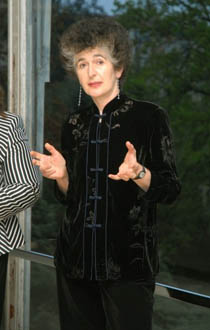
The gallery issued, apart from the auctioned statue, also the furniture from the Villa Tugendhat
 |
The Tugendhat siblings, the children of the original owners, requested the artworks under the law aimed at redressing some of the wrongs caused by the Holocaust. They wanted the statue by Wilhelm Lehmbruck, explaining that they have very strong emotional ties to it. "They want to have it at home as a family heirloom," conveyed Pokorný in November regarding the Tugendhats' position. Nevertheless, the statue will appear in tonight's auction at Sotheby's.
The gallery continues to store a wooden glass-fronted buffet with a construction of cylindrical tubes, a bench made of veneered wood, a table with a beveled top and a steel frame, and a chair with a chrome structure. This was communicated today to ČTK by the gallery's spokesperson, Hana Doležalová. All items were part of the original furnishings of the villa. If the Tugendhats decide to take the furniture, the gallery will likely have to comply.
Based on the same law, the Tugendhats have requested the return of the entire villa. However, according to the legal opinion of the city, this cannot be done in this manner, as the regulation does not mention real estate, only artworks. In their last meeting, representatives agreed that another way must be found to transfer the villa to the heirs. The planned transfer to the state and subsequent restitution was abandoned, and now a transfer through the Moravian Gallery is being considered.
Deputy Mayor Barbora Javorová (KDU-ČSL) told ČTK today that a tripartite agreement should be created between Brno, the Moravian Gallery representing the state, and the descendants of the Tugendhats. This agreement should, for example, stipulate that the future owners of the monument will not remove it from the UNESCO list and that the villa will serve the public. Other agreements will have to be concluded by the parties regarding the transfer of the land associated with the villa.
The Tugendhats promise the representatives of Brno that they will restore the villa to its original state. The auction of Lehmbruck's sculpture therefore surprised some councilors. "It raises doubts about how seriously the Tugendhats want to restore the villa to its original condition," said Mayor Roman Onderka (ČSSD) to Mladá fronta Dnes. One of the daughters of the original owners, Daniela Hammer Tugendhatová, told the paper that the family registered the statue for auction before they requested the return of the villa. However, they do not intend to withdraw it from the auction. She did not confirm whether they want to use the money for the restoration of the building. "We don't even know if it will be ours," she stated in MfD.
Critical voices regarding the Tugendhats are starting to emerge in Brno. According to councilor Daniel Rychnovský (KDU-ČSL), they do not have a clear idea of how to finance the restoration and operation of the villa. The revenue from admission fees, he says, cannot cover the costs. Former mayor and MEP Petr Duchoň (ODS) stated that the city should not give up the villa at all. According to him, the leadership of the South Moravian metropolis should initiate new negotiations and offer the Tugendhats a "special position" in the planned reconstruction. They should have the right not only to oversee the restoration process but also to have a say in the choice of materials used.
The villa has been listed since 2001 as the only Czech modern architecture site on the UNESCO list. The building in the residential area of Černá Pole was designed in 1928 by German architect Ludwig Mies van der Rohe. According to experts, the villa has a unique spatial concept, material selection, and furnishings. Its owners, the spouses Gréta and Fritz Tugendhat, came from a family of prominent textile entrepreneurs. They occupied the house until 1938 when the family emigrated to Switzerland and then to Venezuela to escape the Nazis. After the Nazis occupied Czechoslovakia, the villa was confiscated by the Gestapo in 1940. In 1945, it was seized by the then Czechoslovak state as property of the Nazis.
The English translation is powered by AI tool. Switch to Czech to view the original text source.
2 comments
add comment
Subject
Author
Date
Podivné chování
Idrisi
05.02.07 06:05
...podivné jednání
Janek
06.02.07 12:25
show all comments












